1976 CHEVROLET MONTE CARLO check engine
[x] Cancel search: check enginePage 41 of 102
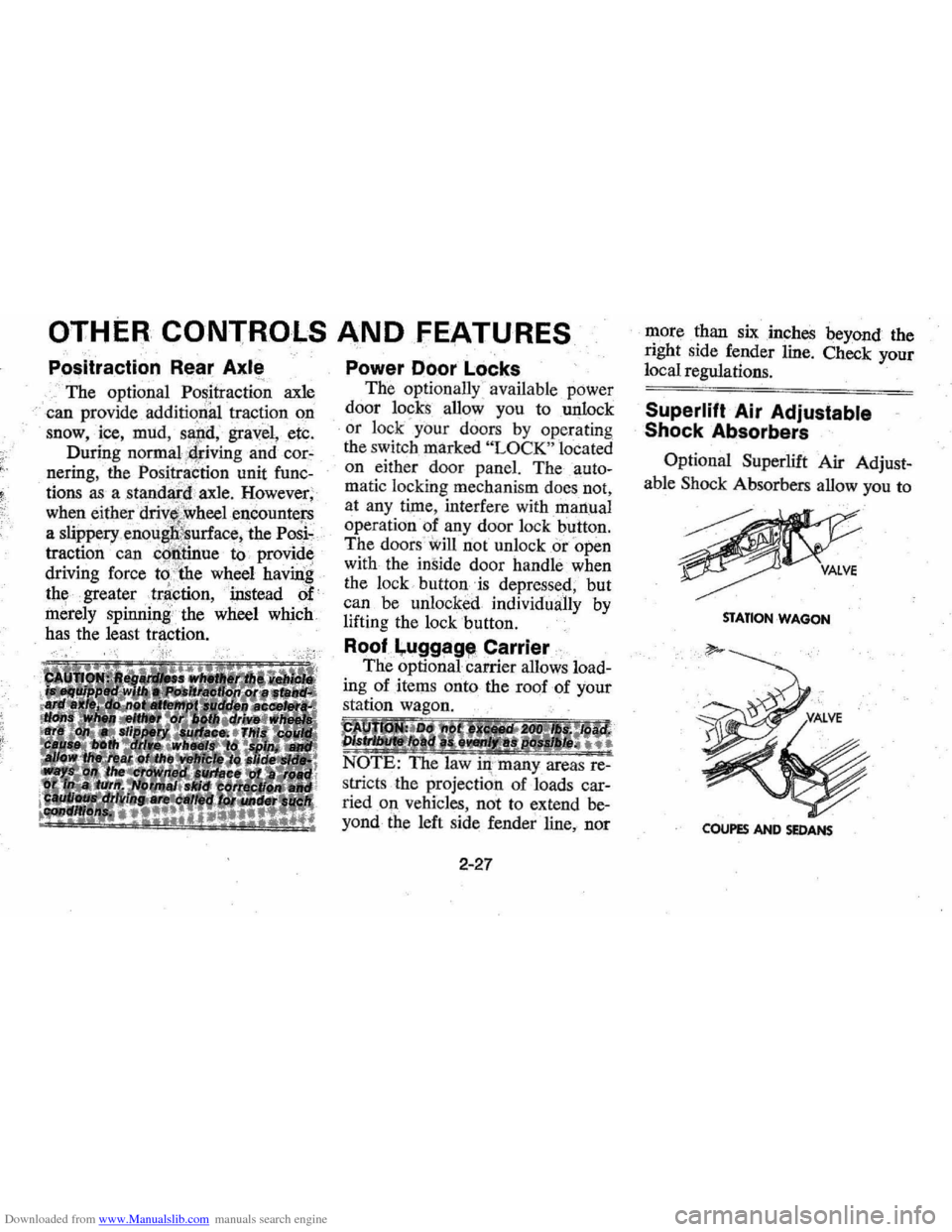
Downloaded from www.Manualslib.com manuals search engine OTHER CONTROLS AND FEATURES
PO$itraction Rea~ Axle
The optional Positraction axle
can provide
additional traction on
snow, ice, mud,
s~d; gravel,etc.
During
normal :4riving and cor
nering, the Positraction unit func
tions as a standard : axle. However ;
when either
drIv&\vheel encounters
a slippery,enoug~urface,the Po;i,
traction can ~i>~~ue to provide
driving force
to.: the wheel havin,g
the greatertr~ction, in,stead of
merely
'" the wheel which
has the least
tra,c:tion.
Power Door Locks
The optionally : available power
door
lo~ks allow you to unlock
, or lock your doors by operating
the switch marked
"LOCK" located
on either door panel. The
auto
matic locking mechanism does not,
at any time, interfere with
mart,ual
operation of any door lock button.
The doors
will not unlock or open
with the inside door handle when
the lock button
is depressed, but
can be unlock .ed individually by
lifting the lock button.
Root~uggag, Carrier
The optionalcarrier allows load
ing of items onto the roof of your
station
~~~;;;;
stricts the projection of car
ried on vehides, not to extend be
yond the left side fender line, nor
2-27
more than six .inches beyond the
right side fender line. Check your
local regulations.
Superlift Air Adjustable
Shock
Absorbers
Optional Superlift Air Adjust
able Shock Absorbers allow you to
STATIO,.. WAGON
COUPES AND SEDANS
Page 49 of 102
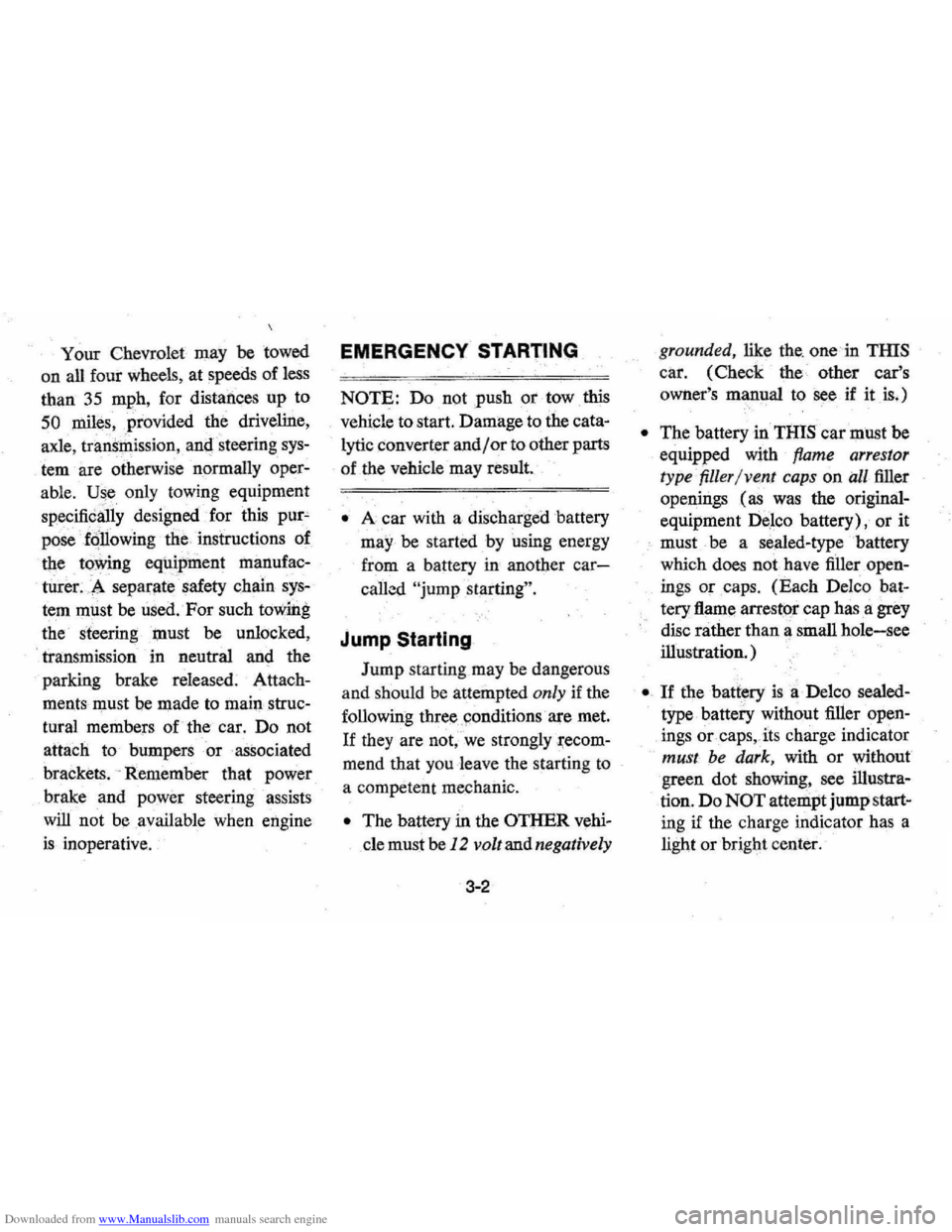
Downloaded from www.Manualslib.com manuals search engine Your Chevrolet may be towed
on all four wheels , at speeds of less
than
35 mph, for distances up to
50 miles, provided the driveline,
axle , tranSmission, and steering
sys
tem are otherwise normally oper
able.
Use only towing equipment
specifically designed for this
pur'
pose following the instructions of
the
towing equipment manufac
turer.A separllte safety chain sys
tem must be used. For such towing
the steeringi;Dust be unlocked,
' transmission in neutral
an~ the
parking brake released. Attach
ments must
oe made to mai!1 ,struc
tural members of the car. Do not
attach to bumpers or
,aSsociated
brackets. ' Remember that power
brake and power steering assists
will not be ,available when engine
is inoperative,
EMERGENCY STARTING
NOTE: Do not push or low this
vehicle to start. Damage to the cata
lytic converter and / or to other parts
of the vehicle may result.
• A car with a discharged 'battery
may be started by using energy
from a battery
in' another car
call<:!d "jump starting ".
Jump Starting
Jump starting may be dangerous
and should
be attempted only if the
followi!1g three , ,~onditions are met.
If they are not, we strongly,~ecom
mend that you leave the starting to
a competent mechanic.
• The battery in the OTHER vehi
cle must be
12 volt and negatively
3-2
grounded, like the, one in TillS
car. (Check the' other car's
owner's manual
to see if it is.)
• The battery in THIS car must be
equipped with
flame arrestor
type
filler / venl caps on all filler
openings (as
was the original
equipment
De ,lco battery), or it
, must be a sealed-type battery
which does not have
fi'tler open
ings or
caps, (Each Delco bat
tery flame arrestor cap has a grey
disc rather than a small hole-see
illustration. )
•. If thebatiery is a Delco sealed
type battery without filler open
ings or
caps"its charge indicator
must be dark, with or without
green dot showing, see illustra
tion. Do
NOT attempt jump start
ing
if the charge indicator has a
light or bright center.
Page 53 of 102
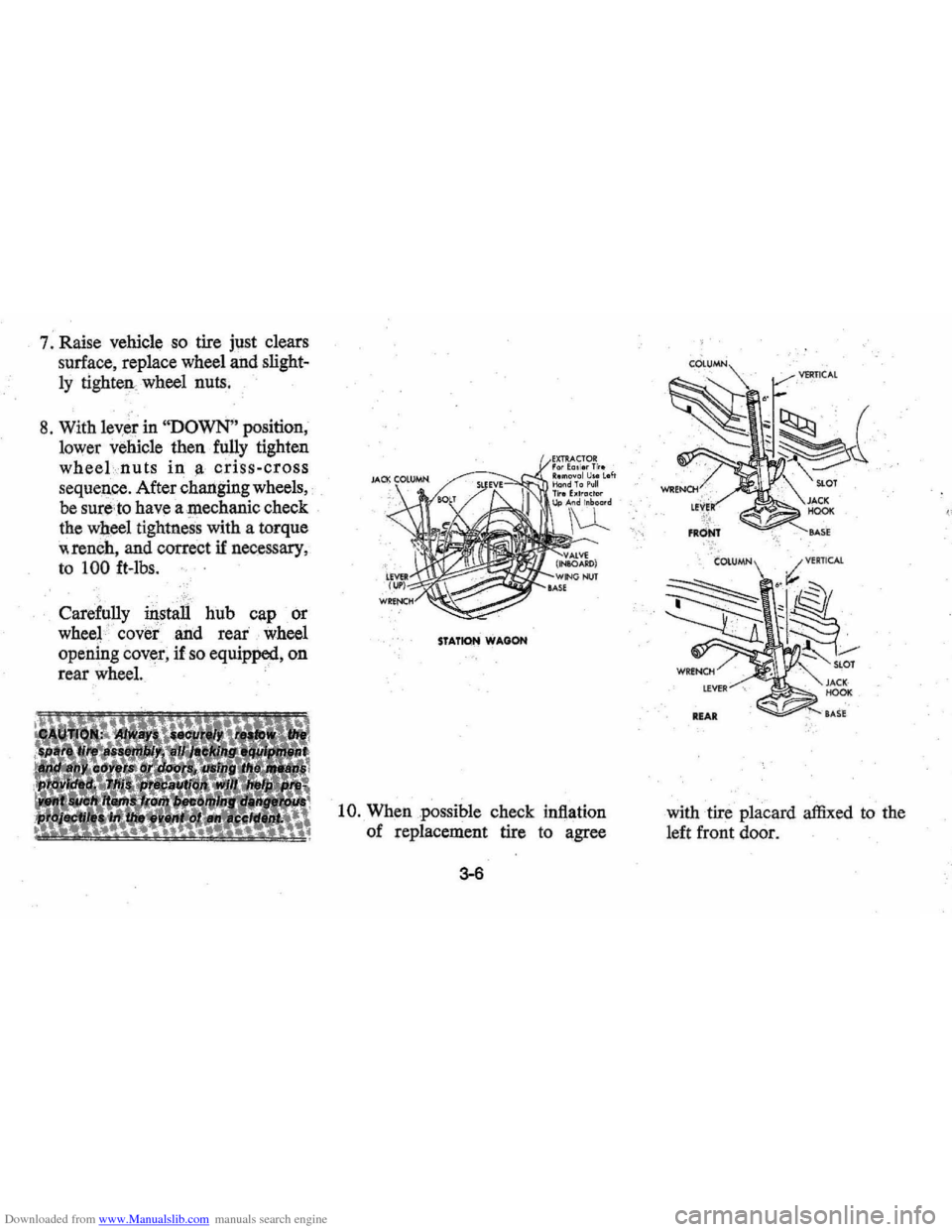
Downloaded from www.Manualslib.com manuals search engine 7. Raise vehicle so tire just clears
surface, replace wheel and
slight
ly tighteawheel nuts.
8. With leyer in "DOWN" position,
lower vehicle then fully tighten
wheeLnuts in a criss-cross
seq ueIice. After chariging wheels,
be sure,to have a mechanic check
the wheel tightness with a torque
"rench, and correct if necessary ,
to 100 ft-lbs.
Carefully instali hub cap or
wheel '
covet and rear.' wheel
opening cover, if
so equipped, on
rear wheel.
.
STATION WAGON
10. When possible check inflation
of replacement tire
to a,gree
3-6
with tire placard affixed to the
left front door.
Page 64 of 102
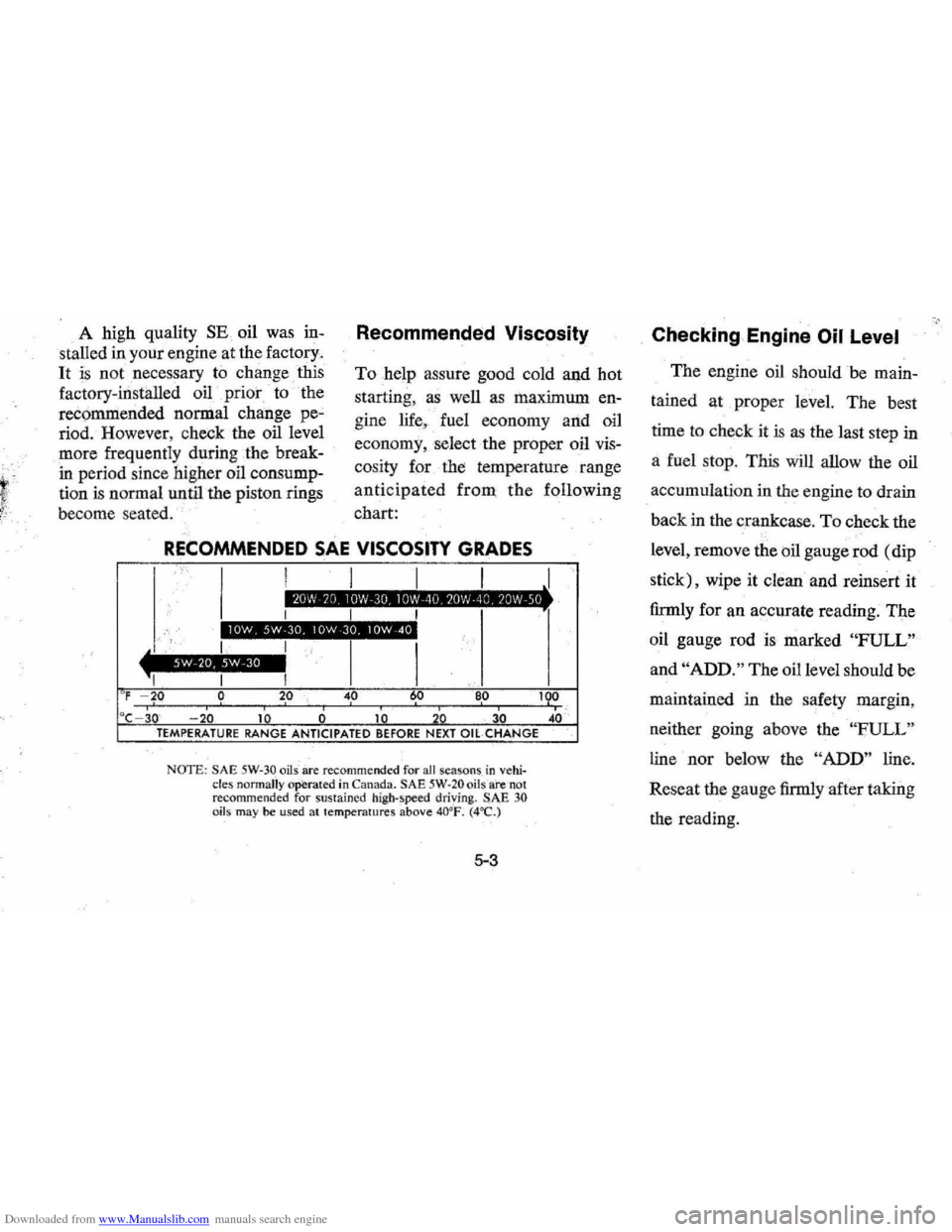
Downloaded from www.Manualslib.com manuals search engine A high quality SE oil was in
stalled in
your engine at the factory.
It is not necessary to change this
factory-irtstalled oil prior to the
recommended normal chartge pe
riod . However , check the oil level
more frequently during the break
in period since higher oil consump
tion is normal until the piston rings
becom e sea ted.
Recommended Viscosity
To help assure good cold and hot
starting, as well as maximum en
gine life, fuel economy and oil
economy , select the proper oil vis
cosity for
the temperature range
anticipated from the following
chart:
RECOMMENDED SAE VISCOSITY GRADES
I I I I 20W 20 lOW 30 lOW 10 7(lV, 10 JOW 50
JOW 5w 30 lOW 30 lOW 40
sw 20 5W 30
F --;fO , ? ,2,0 ,4,0 ~O 8,0 , 1~
°c 30' 20 10 0 1 30 40 TEMPERATURE RANGE ANTICIPATED BEFORE NEXT OIL,CHANGE
NOTE: SAE 5W-30 oils· are rec ommended for all seasons in vehicles normally operated in Canada. SAE 5W-20oi ls are nol recommended fur su stained high-speed driving. SAE 30 oi ls may be used at tempera tures above 4O"F. (4"C.)
5-3
Checking Engine Oil Level
The engine oil should be main
tained
at proper level. The best
time
to check it is as the last step in
a fuel stop. This will allow the oil
accumulation in
the engine to drain
back in the crankcase.
To check the
level, remove the oil gauge rod (dip
stick), wipe it clean and reinsert it
firmly for an accurate reading. The
oil gauge rod is marked
"FULL"
and "ADD." The oil level should be
maintained in the safety margin,
neither going above the
"FULL"
line nor below the "ADD" line.
Re sea t the gauge firmly after taking
the reading.
Page 65 of 102
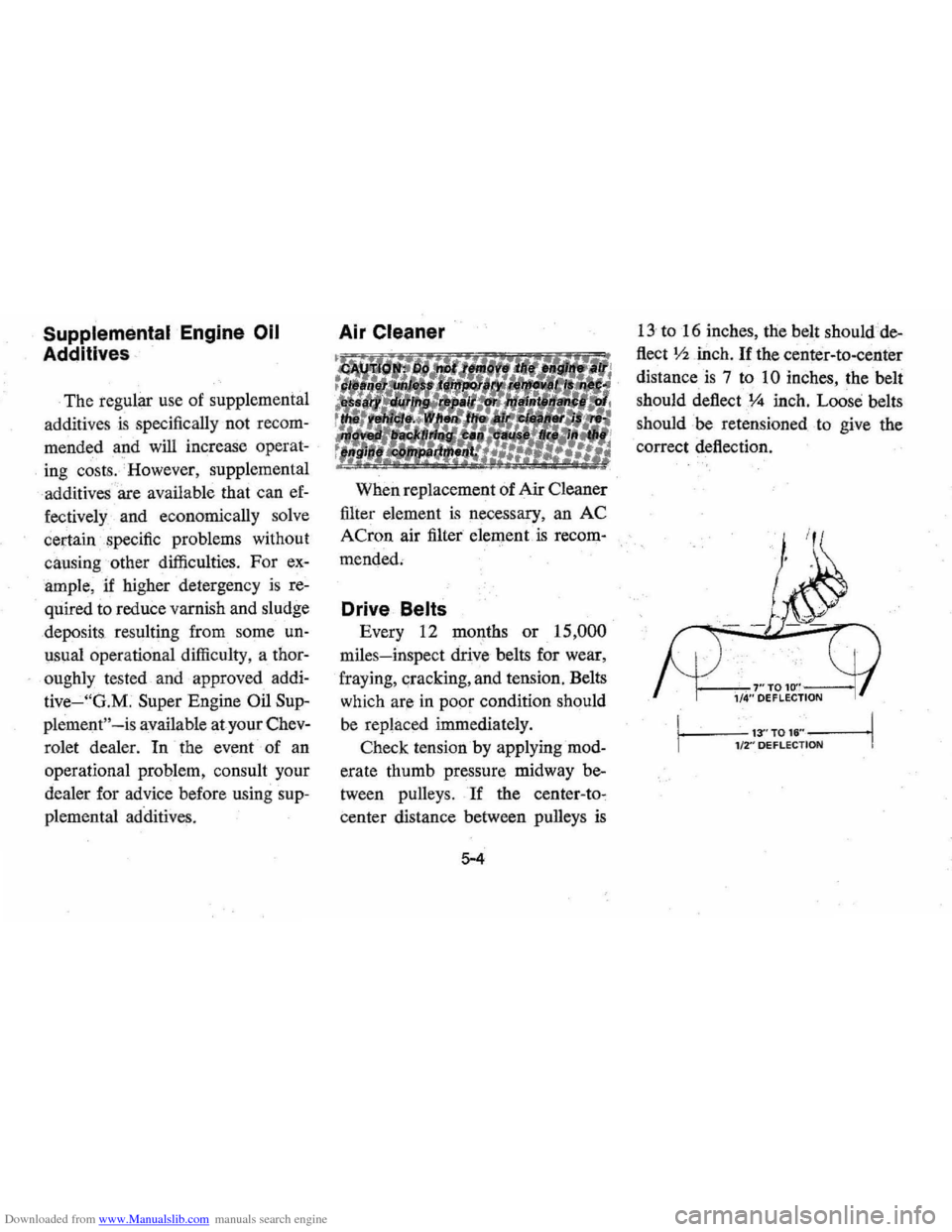
Downloaded from www.Manualslib.com manuals search engine Supplemental Engine 011
Additives·
The regular use of sUpplemental
additives is specific ally not recom
mended
and will increase operat
ing costs . However , supplemental
additives are avail able that can ef
fectively and economicall y solve
certain specific problems without
c ausing other difficulties . F
or ex
ample , if higher detergen cy i s re
quired to reduce varnish and sludge
deposit
s. resulting from some un
usual operational difficulty, a thor
oughly te sted and approved addi
tive-"G.M. Super Engine Oil Sup
plement "
-is availabl e at your Chev
r olet dealer.
In the event of an
operation al problem, consult your
dealer for advice before using sup
plemental additives.
Air Cleaner
When replacement of Air Cleaner
filter element
is ne cessary , an AC
ACron air filter element is recom
mended ,
Drive Belts
Every 12 mOJ.1ths or 15,000
mil es-inspect drive belts for wear ,
fraying,
qracking, and tension. Belts
which
are in poor condition should
be replaced immediately .
Check tension by applying mod
erate thumb pressure midway be
tween
pUlle y s. If the center-to ,
center distance between pulleys is
5-4
13 to 16 inches, the belt should de
flect Y
2inch. If the center -to-center
distance
is 7 to 10 inches, the belt
should
deflect .v.. inch. Loose belts
should be retensioned
.to give the
correct deflection.
>-~-7"TO'O"---1/4" DEFLECTION
I ... '3"TO"" I r-m"DEFLECTI~
Page 66 of 102
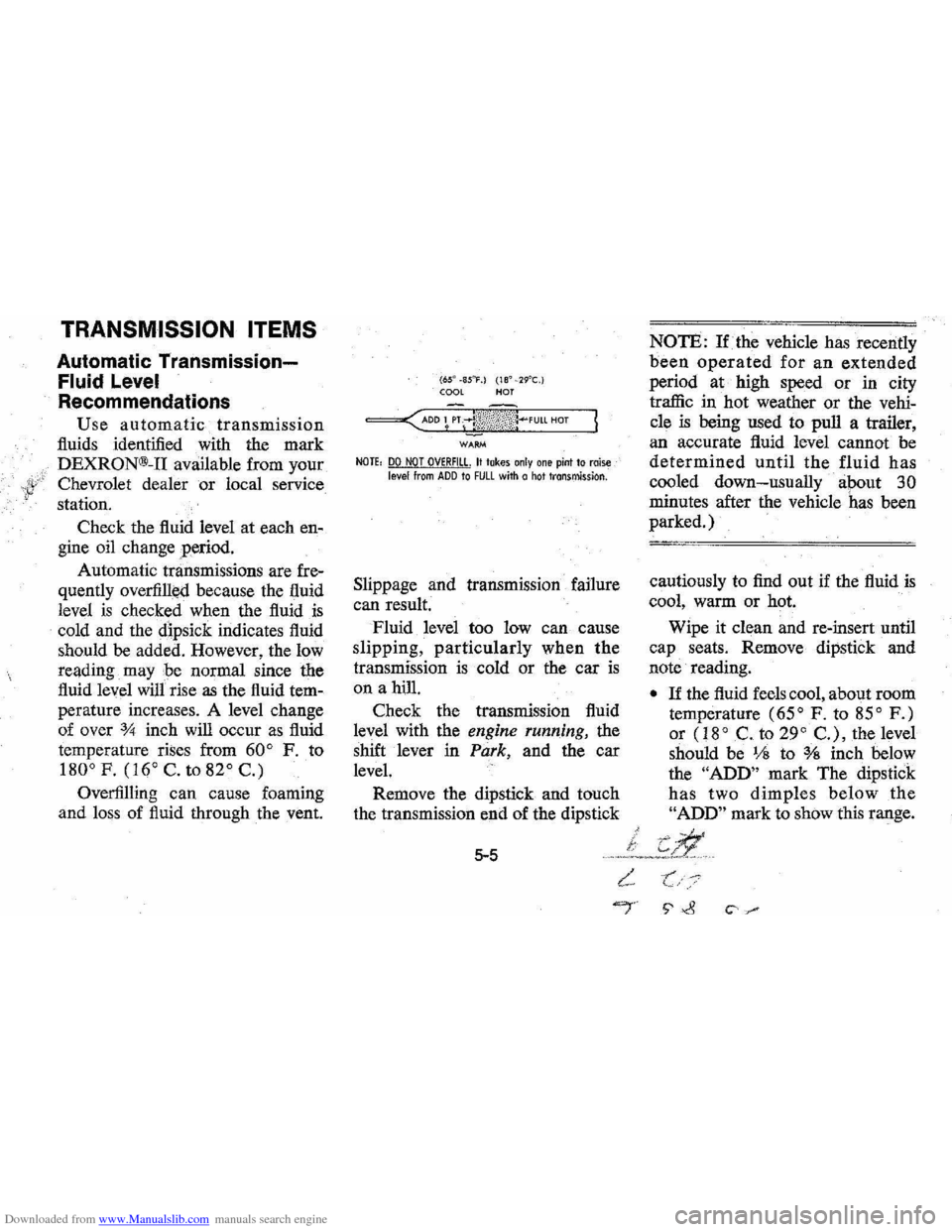
Downloaded from www.Manualslib.com manuals search engine TRANSMISSION ITEMS
Automatic Transmission
Fluid Level
Recommendations
Use automatic transmission
fluids identified with the mark
DEXRON®-II available from your
Chevrolet dealer
or local service
station.
Check the fluid level
at each en
gine oil change period.
Automatic transmissions are
fre
quently overfill¢
level
is checked when the fluid is
cold and the dipsick indicates fluid
should be added. However, the low
reading may
be normal since the
fluid level will rise as the fluid tem
perature increases. A level change
of over
% inch will occur as fluid
temperature rises from
60° F. to
180° F. (16° C. to 82° C.)
Overfilling can cause foaming
and loss of fluid through the vent.
(650 -8S"F.) (18" _29°C.) COOL HOT
WARM
NOTE, DO NOT OVERFill. It takes only one pint to raise level from ADD to FULL with a hot transmission.
Slippage and transmission failure
can result.
Fluid level too low can cause
slipping, particularly when the
transmission is cold or the car is
on a hill.
Check the transmission fluid
level with the
engine running, the
shift lever
in Park, and the car
level.
Remove the dipstick and touch
the transmission
end of the dipstick
5-5
L.
NOTE: lithe vehicle has recently
been operated for an extended
period at high speed or in city
traffic
in hot weather or the vehi
cle is being used to pull a trailer,
an accurate fluid level cannot be
determined until the fluid has
cooled down-usually apout 30
minutes after the vehicle has been
parked.)
cautiously to find out if the fluid is
cool, warm or hot.
Wipe it clean and re-insert until
cap seats. Remove dipstick and
note reading.
• If the fluid feels cool, about room
temperature
(65° F. to 85° F.)
or (18° C. to 29° C.), the level
should
be 1;8 to % inch below
the
"ADD" mark The dipstick
has two dimples below the
"ADD" mark to show this range.
"'j' S' ~ c· "
Page 68 of 102
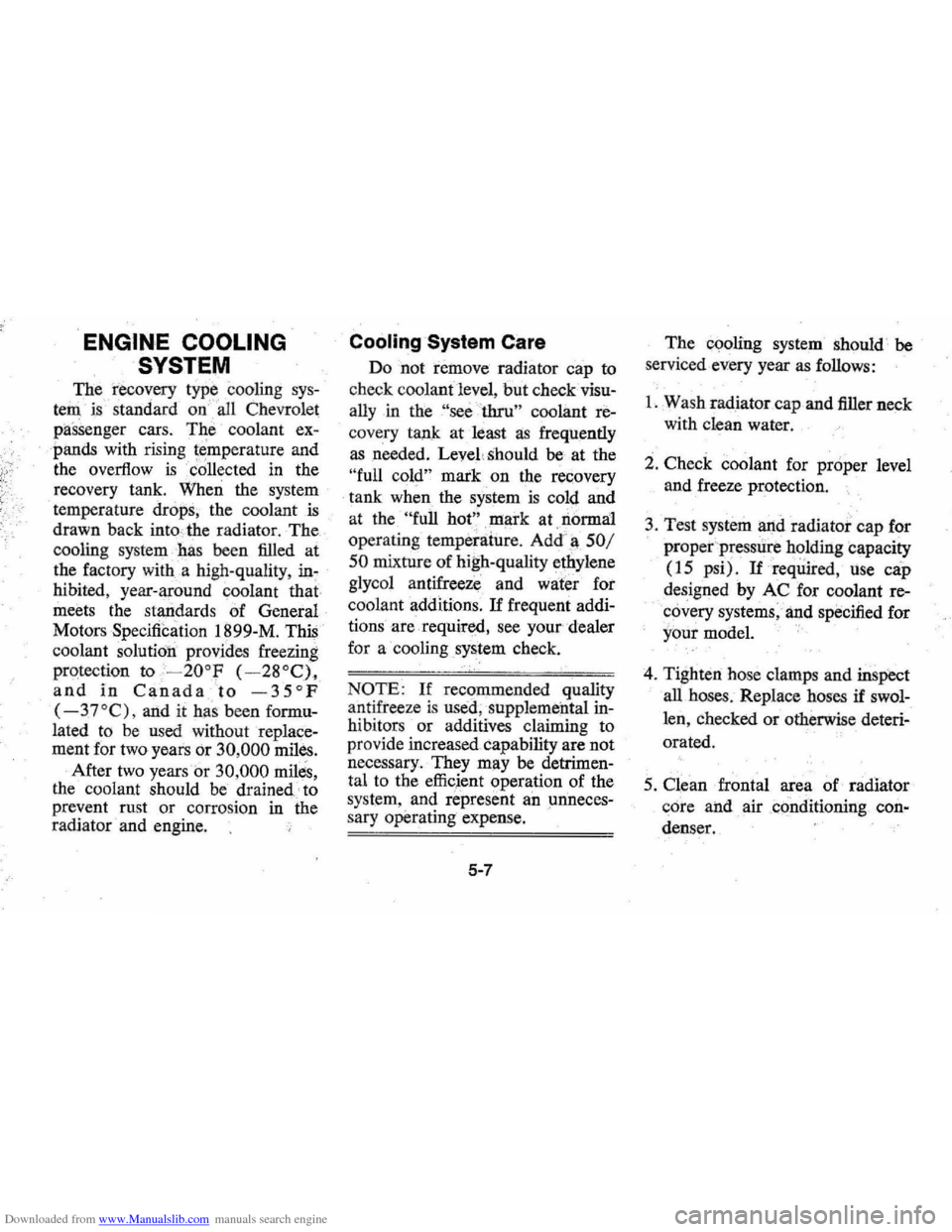
Downloaded from www.Manualslib.com manuals search engine ENGINE COOLING
SYSTEM
The recovery type cooling sys
tem is standard on all Chevrolet
pasSenger cars. The coolant ex~
pands with rising temperature and
the overflow
is dOllected in the
recovery tank.
When the system
temperature drops, the coolant is
drawn back
intocthe radiator. The
cooling system has been filled at
the factory with a high-quality, in
hibited , year-around coolant that
meets the standards
of General
Motors Specification I
899"M. This
coolant solution provides freezing
protection
to -20oP (-28°C),
and in Canada to _35°P
( -37°C), and it h~s been formu
lated to be used without replace
ment for two years or 30,000 miles.
After two years
or 30,000 miles,
the coolant should be drained to
prevent rust or corrosion in the
radiator and engine.
Cooling System Care
Do not remove radiator cap to
check coolantlevel , but
checkvisu
ally in the "see 'thru " coolant re
covery tank at least as frequently
as ,needed. LeveL should be at the
"full cold" mark on the recovery
tank when the system
is cold and
at the
"full hot" roark at Iiormal
operating temperature. Add'~ 501
50 mixture of high-quality ethylene
glycol antifreeze and
waler for
coolant additions.
If frequent addi
tionsare required, see your dealer
for
a cooling system check.
NOTE: If recommended quality
antifreeze
is used,supplemental in
hibitors or additives claiming to
provide increased capability are
not
necessary. They may be detrimen
tal to the efficient operation of the
system, and represent an
unneces
sary operating expense.
5-7
The cooling system should be
serviced every year as follows:
1. Wash radiator cap and filler neck
with clean water.
2. Check coolant for proper level
and freeze protection.
3. Test system
and radiator cap for
, properpresslire holding capacity
(15 psi).
Ifreqitired, use cap
designed by
AC for coolant re
co~ery systems, and specified for
your model.
4, Tighten hose clamps and
inspect
all hoses. Replace hoses if swol
len, checked or otherwise deteri
orated.
5. Clean frontal area of radiator
, qcire and air conditioning con
denser.
Page 70 of 102
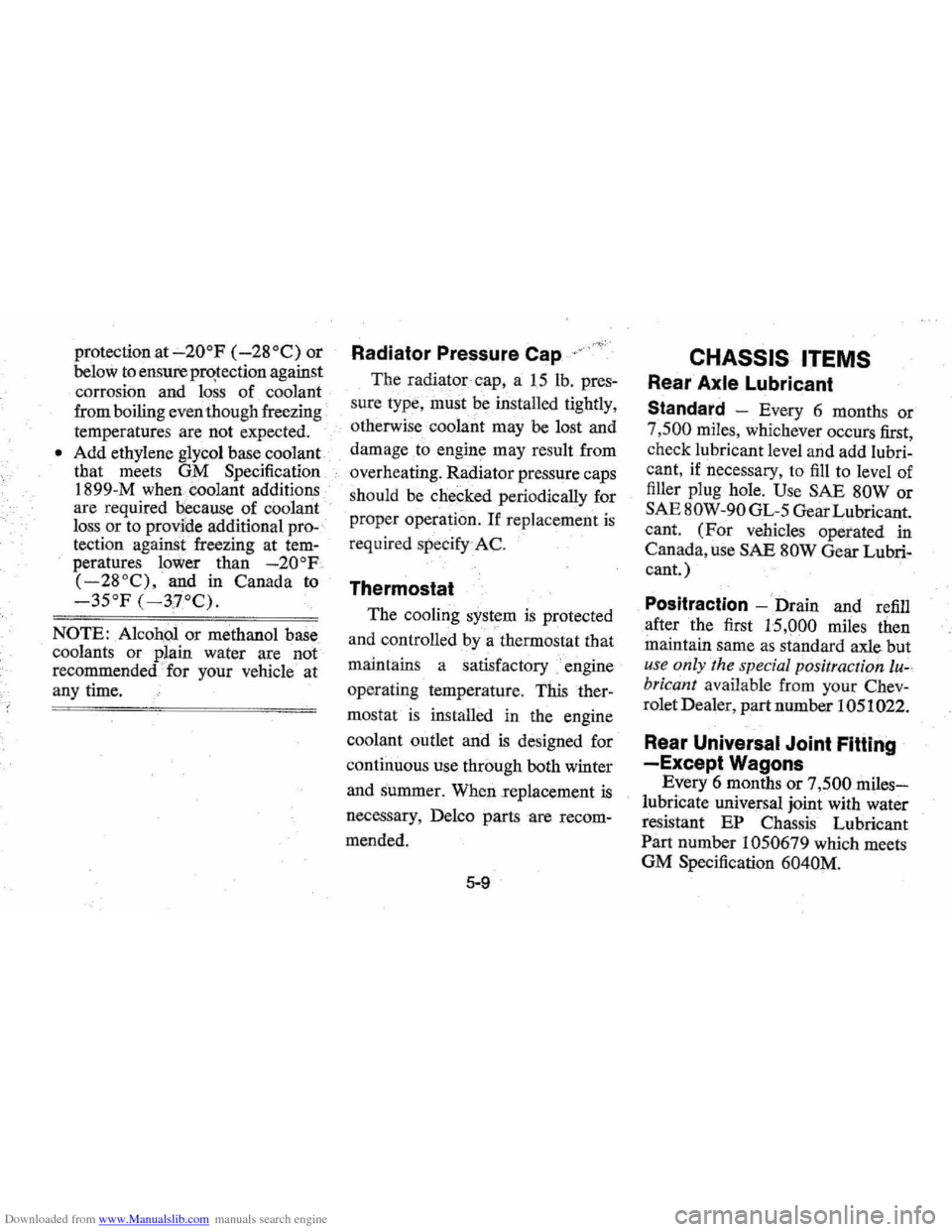
Downloaded from www.Manualslib.com manuals search engine --;
protection at-20op (-2S0C) or
below to ensure pro;tection against
corrosion and loss
of coolant
from boiling even though freezing '
temperatures are not expected.
• Add ethylene glycol base coolant
that meets
GM Specification
IS99-M when coolant additions
are required because of coolant
loss
Or to provide additional pro"
tection against freezing at tem_
peratures lower than _20oP,
(-2S0C),' and in Canada to
_35°P ( -3JOC).
NOTE: AlcOhol Or methanol base
coolants or plain water are not
recommended for your vehicle at
any time.
Radiator Pressure Cap
The radiator cap, a 15 lb. pres
sure type, must be installed tightly,
otherwise coolant may be lost and
damage
, to engine may result from
overheating. Radiator pressure caps
should
be chef'ked periodically for
' proper operation.
If replacement is
required specify·AC.
Thermostat
The cooling system is protected
and controlled by a thermostat that
maintains a satisfactory
" engine
operating temperature . This
ther
mostat is installed in the engine
coolant outlet
arid is designed for
continuous use through both winter
and
s ·ummer. When replacement is
necessary, Delco parts are recom
mended.
5-9
CHASSIS ITEMS
Rear Axle Lubricant
Standard -
Every 6 months or
7,500 miles , whichever occurs first,
check lubricant level and add
lubri
cant, if necessary, to fill to level of
filler plug hole.
Use SAE SOW or
SAE SOW-90 GL-5 Gear Lubricant.
cant.
(Por vehicles operated in
Canada, use
SAE SOW Gear Lubri
cant.)
Posilraction -Drain and refill
after
the first 15,000 miles then
maintain same
as standard axle but
use only the special positraclion lu-·
bricant available from yo ur Chev
roletDealer , part number 1051022.
Rear Universal Joint Fitting
-Except Wagons
Every 6 months or 7,500 miles
lubricate universal joint with water
resistant
EP Chassis Lubricant
Part number 1050679 which meets
GM Specification 6040M.